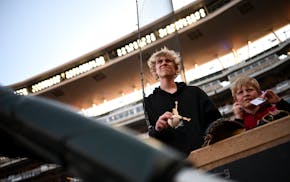Anytime after mid-August and into early September, birders are aware that it's nighthawk migration time. In afternoons and early evenings, flocks of these dark, blue jay-size birds with long pointed wings and white wing patches can be seen gliding, diving and circling, feeding on insects in the air and definitely heading south. Having been summer residents throughout Minnesota, the common nighthawks are on their way to winter in South America.
The common nighthawk is a wide-ranging aerial forager found regularly over many habitats, including prairie, cropland, woodlands, wetlands — even the residential and business districts of towns and cities. During fall migration, sometimes as many as 1,000 nighthawks are seen in a single flock. Large migration flights have been recorded every year in Duluth, where nighthawks can number up to 1,000 per hour in the late afternoons between Aug. 18 and 25.
For me, looking into the sky and spotting the first loose flock of nighthawks marks the beginning of autumn. It's true that Labor Day marks the official end of summer's social flurry. It's also true that the autumnal equinox the third week of September marks the end of celestial summer. But August slowly cools toward September and autumn. The time after the first of the common nighthawks moves through is one of the best times to be outdoors, enjoying the cool fresh weather fronts as they pass by, giving us crystalline late-summer weather. The lakes are still warm enough for swimming, the insect chorus is great and there is plenty of food for wild creatures.
Jim Gilbert's Nature Notes are heard on WCCO Radio at 7:15 a.m. Sundays. His observations have been part of the Minnesota Weatherguide Environment Calendars since 1977, and he is the author of five books on nature in Minnesota. He taught and worked as a naturalist for 50 years.
Webb Simpson offers to resign from PGA Tour board. But only if McIlroy replaces him, AP source says

Live: Twins vs. White Sox. Follow the action on Gameview
![Glen and Becky Taylor during game 1 on Saturday, April 20, 2024, at Target Center in Minneapolis, Minn. ] CARLOS GONZALEZ • carlos.gonzalez@startri](https://arc.stimg.co/startribunemedia/X74AVHP3ZBD4TPPPDJTNX5LN6M.jpg?h=91&w=145&fit=crop&bg=999&crop=faces)
Gameview: Wolves vs. Suns in Game 2. Up-to-the-second updates here.
Paris main airport unveils new baggage handling system ahead of the 2024 Olympics

